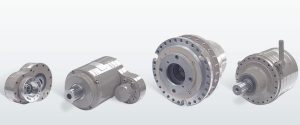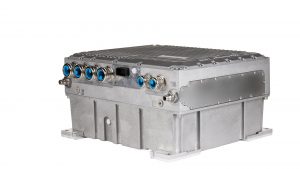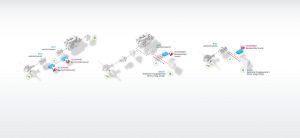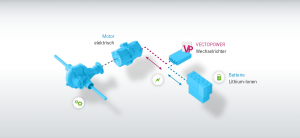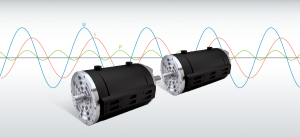Introduction
DC/DC converters are for adapting two different DC voltages to each other. In mobile applications, for example, a DC/DC converter can be use to connect an electric output from energy stores, such as batteries or supercapacitors, with volatile voltages used to a system with a stabilized voltage. The following considerations focus on the advantages of such DC/DC converters but also examine the classic disadvantage of less than 100 % efficiency. As we will see, an efficiency of 98-99 % can be achieved with suitable technology and design, making this disadvantage surprisingly minor. Nevertheless, the advantages and disadvantages of using DC/DC converters must be carefully weighed. The following presentation is to provide an initial overview
Table of contents
- 1 A few basics
- 1.1 Possible use of DC/DC converters
- 1.2 Attainable efficiencies
- 1.3 Application with capacitor stores
- 1.3.1 Calculation example
- 1.4 Connection of batteries
- 1.5 Additional benefit of DC/DC with battery applications
- 1.6 Application with fuel cells
1 A few basics
1.1 Possible use of DC/DC converters
In general, we can distinguish between:
- DC/DC for unidirectionally increasing voltages, for example, from fuel cells
- DC/DC for bidirectionally connecting batteries and/or capacitors
- DC/DC for unidirectional increasing or decreasing a DC voltage for consumers or inverters that need the other level. This is a rather specialized application, which we will not explicitly examine in the following.
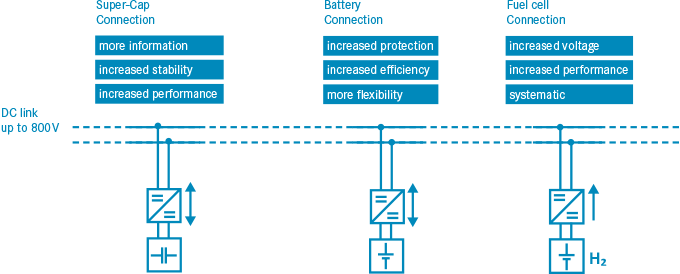
In addition, we have to distinguish between DC/DC with and without electrical isolation. DC/DC with electrical isolation is used, for example, when a touchable safety extra-low voltage has to be connected to a high-voltage system. In the following, we will exclusively consider DC/DC converters that work bidirectionally and are designed without electrical isolation.
1.2 Attainable efficiencies
Here are actual measured values of a VP5000-DC200 in an application where a battery with 500 VDC is connected to a stabilized DC link with either 600, 650, or 700 VDC.
If we consider the blue curve (500 V to 700 V), then we see that the efficiency for charging as well as for discharging is in a large working range near 99 %. Even if we operate with only five of the 400 possible amperes (this is a load of 1.25 %), we still achieve 92 %.
- ARADEX advantage: Very high efficiencies can be achieved with DC/DC converters in an extremely wide performance range by using appropriate technology and material.
Functionally, the efficiency in the present technical version decreases, the higher the difference in voltage between the input and output is. In the following, let us therefore consider output voltages of 300 V to 700 V and even 100 V to 700 V, for example.
- Even with an increase from 100 V to 700 V, it is possible to achieve an effi ciency of approx. 94 %. In addition, a 300 V battery, which is commonly found in vehicles, can be successfully connected to 700 V with nearly 98 %, for example.
- ARADEX advantage: Excellent efficiencies can be achieved even with high voltage increases.
This makes it possible, for example, to combine energy sources and energy stores with very different voltages in an overall system with stabilized voltage.
1.3 Application with capacitor stores
If we charge capacitor stores to max. 700 VDC and connect to a 750 VDC DC link via DC/DC, for example, and discharge the capacitors to 100 V, then according to W = ½ * C*U², we use:
dW = ½*C*(700V*700V – 100V*100V), which is 98% of the stored energy.
Even if we „only“ discharge to 200 V, we still use over 91 % of the energy.
- ARADEX advantage: As energy stores, capacitors allow a very high percentage of the stored energy to be used and can therefore be designed smaller.
1.3.1 Calculation example: Traction drive: A 26 ton truck brakes from 80 km/h to a standstill. This kinetic energy is to be stored.
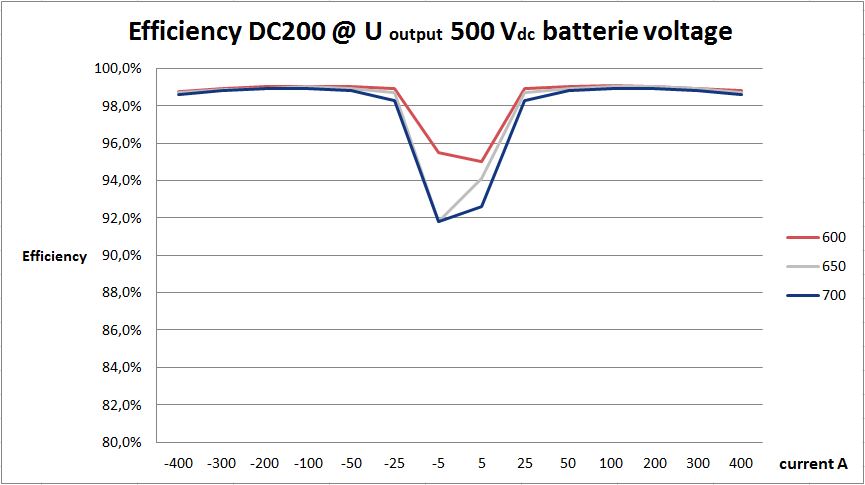
fig. 2
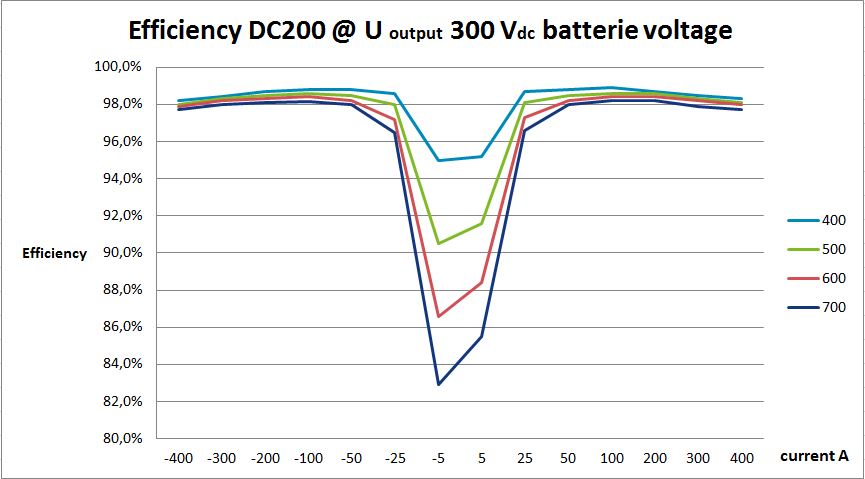
fig. 3
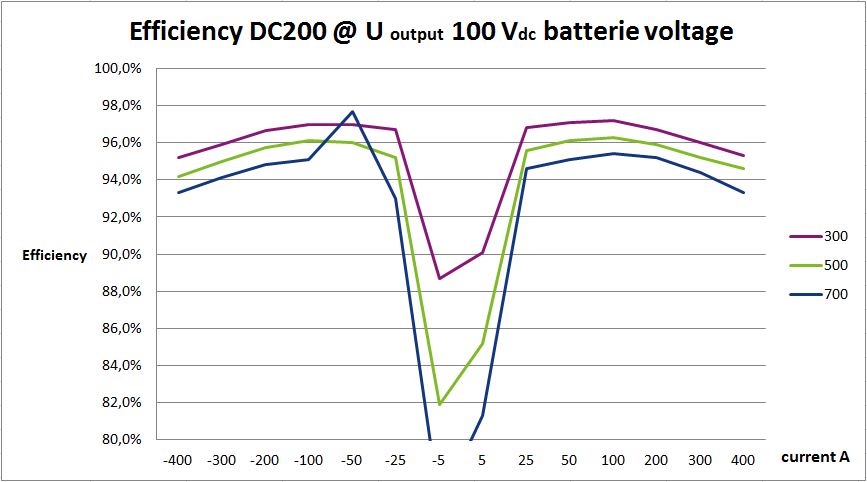
fig. 4
Case 1: Without a DC/DC converter: Assuming a permissible DC link voltage change of approx. -15 % (from 700 VDC to 600 VDC): A capacity of C =98 F is required to store the energy of 6.4 MJ without a DC/DC converter
Case 2: Assumption: A supercapacitor is to be discharged to 30 % (= 210 VDC): The capacity is now only: C=29 F
1.4 Connection of batteries
Even batteries with very „flat“ voltage characteristics, such as LiFePo cells, have a working range of the voltage Vmax/Vmin = 1.25 in actual operation.
If we connect so many cells in series that the maximum voltage is 750 VDC, the minimum voltage in the normal operating range will be 600 V. This factor alone would require overdimensioned lines and inverters in the case that the battery forms the DC link without DC/DC. See the white paper „Calculation and dimensioning for drives“ for more information.
If a stabilized 750 VDC is used as a basis, the same inverter will provide 14.5 % higher capacities. Alternatively, cable cross sections, terminals, and inverters can also be designed 13 % smaller (1/1.145 = 0.87) with the given capacity.
| UZK | P Motor1 (410 VAC) rel. | P Motor2 (512 VAC) rel. |
| 600 VDC | 100% | no function |
| 750 VDC | 91,7% | 114,5% |
1.5 Additional benefit of DC/DC with battery applications
If several batteries are each connected to a central DC supply via their „own“ DC/DC, a highly redundant system can be created:
- Batteries „with problems“ can be easily disconnected on the fly
- Batteries that show a power limit – and these are by far the most common damage symptoms in practical applications – can still be used. They are simply supplied with less power on the fly by parameterizing the DC/DC but do not drop out completely.
- ARADEX advantage: Even batteries that have an acute technical limit can continue to be used, which increases the availability of the system.
- ARADEX advantage: Batteries with different technology can be combined in one system, e.g. a high-power cell combined with others that have less power but more energy.
1.6 Application with fuel cells
Functionally, fuel cells have a very „soft“ voltage characteristic. The voltage in the range of the nominal power is only around 50 % of the idle voltage. In addition, fuel cells are preferably designed with low system voltages, in order to keep the number of elements to be connected in series as low as possible. A stack with around 100 cells in series thus produces an idle voltage in the range of 224 VDC and a voltage of around 120 VDC under nominal load.
With DC/DC, we can increase even these very low voltages to the usual DC system voltages of 600 – 750 VDC with a sufficiently good efficiency.

